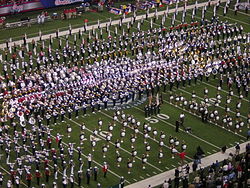
Back Espectáculo de medio tiempo Spanish Pertunjukan paruh waktu ID ハーフタイムショー Japanese 하프타임 쇼 Korean
This article needs additional citations for verification. (July 2014) |


A halftime show is a performance given during the brief period between the first and second halves, or the second and third quarters, of a sporting event. Halftime shows are not given for sports with an irregular or indeterminate number of divisions (such as baseball or boxing), or for sports that do not have an extended period of stoppage in play. Ice hockey games consist of three periods, so there are in effect two halftimes at a hockey game: the first intermission is between the first and second periods, and the second intermission comes between the second and third periods. The intermissions are usually given over to contests involving randomly selected audience members, although for major games, like the Winter Classic, the Stanley Cup Finals, the NHL All-Star Game and the Frozen Four, the intermission between the 2nd and 3rd period often features entertainment typically found during halftime shows.[1]
The first instance of a halftime show was in November, 1892 at the University of Nebraska-Lincoln when General John J. Pershing required the ROTC band to march drills as a part of their performances. This was first showcased at a football game where the band marched drills at halftime. Since the band's military reviews had attracted significant crowds, the goal was to increase attendance at football games by conducting a military review while the team rested between halves.
Others generally attribute the invention of the halftime show to Walter Lingo. Lingo was the owner of a dog kennel and sponsored an all-Native American football team, the Oorang Indians, to tour the country and promote the kennel. In addition to playing football, the Indians would provide various forms of entertainment, including exhibiting the dogs, players demonstrating their prowess (Nick Lassa once wrestled a bear while Jim Thorpe would kick long-distance field goals), dancing, and demonstrations of native culture. Although the halftime show was in part designed to bring an additional draw to mask the fact that the Indians did not put much effort into the actual game, his halftime show was mostly the same from game to game, and the novelty wore off after two years.[2][3]
A modern halftime show can consist of cheerleading performances, majorette routines, marching bands playing music, or other spectacular performances. Halftime shows are particularly well known among historically black colleges and universities, which have elaborate "battles of the bands" between the opposing schools' marching bands during halftimes of the most prominent games (see, for instance, the Bayou Classic). More common in modern times, especially in major games, is to reserve the entire halftime period for a short concert by a major recording artist.[citation needed]
The halftime show also often describes television studio shows during the intermission which review scores and stories from across the league's schedule during that break between action.
- ^ Pevos, Edward (2018-01-17). "Kid Rock NHL All-Star Game headlining gig gets mixed reactions". mlive. Retrieved 2019-09-30.
- ^ Tramel, Jimmie (September 13, 2009). "NFL's Indians were rich in Oklahomans". Tulsa World.
- ^ Borowski, Sam (January 5, 1995). "Oorang Indians: One of the First NFL Teams". Indian Country Today. Lakota Times. Archived from the original on September 12, 2017. Retrieved August 1, 2012.